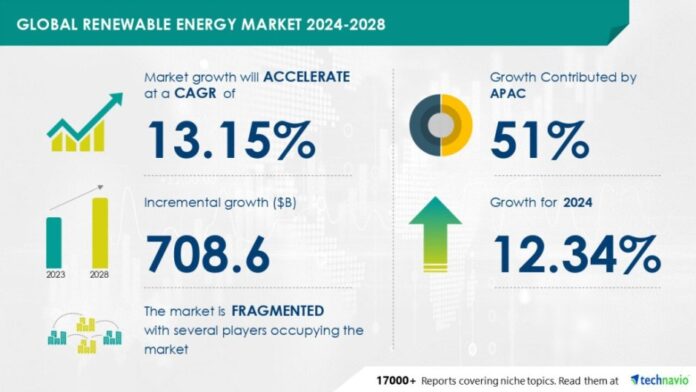The global renewable energy market is projected to grow by USD 708.6 billion from 2024-2028, with a CAGR of 13.15 percent.
The rise in global energy demand and the popularity of clean energy technologies are key drivers, while competition from alternative energy sources presents a challenge, according to Technavio.
Major players include ABB, Acciona, Duke Energy, EnBW Energie Baden Wurttemberg, Enel, ENERCON, General Electric, Goldwind, Innergex Renewable Energy, Invenergy, Nextera Energy, Schneider Electric, Siemens, Sinovel Wind Group, Sunrun, Suzlon Energy, Tata Power, Vattenfall, Vestas Wind Systems, and Xcel Energy.
Renewable energy growth is influenced by energy security concerns, investment costs, and government policies. Solar PV capacity is expanding, with utility-scale and distributed systems gaining traction. Electricity prices are rising due to the global energy crisis, increasing the competitiveness of renewables. Governments are introducing incentives to accelerate construction and grid integration.
Wind energy, including onshore and offshore, is a major player, alongside hydropower, bioenergy, and geothermal energy. Decreasing module prices are making renewables more affordable, while environmental concerns and ESG considerations drive demand. Battery storage systems are gaining importance to manage intermittency and ensure energy security. The market is also seeing trends in off-grid energy solutions, smart cities, and heating applications.
Urbanization and industrialization, especially in China and India, have significantly increased electricity demand, leading to higher fossil fuel consumption. In 2022, CO2 emissions from electricity and heat production accounted for over 42 percent of global emissions. This has driven investment in wind, solar, and hydro to reduce fossil fuel reliance and lower greenhouse gas emissions. However, high interest rates and investment costs hinder the expansion of renewable projects, particularly in utility-scale solar and wind energy. Policymakers are addressing these challenges through incentives and regulatory reforms, but permitting and policy delays persist.
Despite growth in renewables, fossil fuels remain dominant. In 2022, coal accounted for over 38 percent of global electricity generation, natural gas for 23 percent, and oil for 3 percent, according to the IEA. Advanced coal technologies have extended coal-powered generation, while some countries continue relying on fossil fuels due to infrastructure and resource availability. Renewables, particularly solar and wind, are gaining ground due to government incentives and decreasing costs, but challenges remain in grid integration, storage, and policy execution.
The residential sector, a major energy consumer, is transitioning toward renewables to combat inefficiency and environmental concerns. Solar and wind energy are key solutions, supported by government incentives and electrification goals. The shift to clean energy is crucial for sustainability, reducing pollution, and preserving resources.
Technological advancements, policy frameworks, and investment trends are shaping the future of renewable energy. Battery storage solutions are critical for grid stability, while wind turbines and offshore wind projects are gaining traction. Ocean power and geothermal energy are emerging with significant potential. Renewables are increasingly cost-competitive with fossil fuels, even without subsidies. However, permitting delays, auction undersubscription, and policy shifts could impact market growth. CO2 emissions remain a major concern, reinforcing the need for sustainable energy solutions. The market is expected to continue evolving with innovation, affordability, and environmental consciousness at the forefront.
GreentechLead.com News Desk

